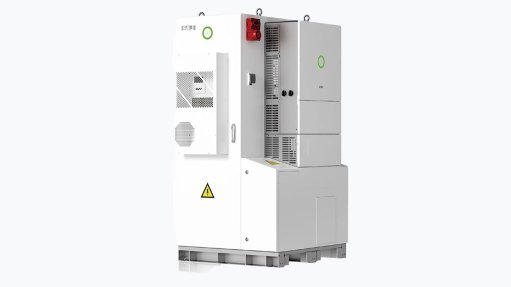GoMetro unpacks hub model for electric minibus taxi rollout
Mobility platform GoMetro on July 13 unpacked its research and work so far in introducing South Africa’s first battery electric minibus taxi and charging infrastructure solution, including how the biggest challenges can be overcome and what costs could be saved.
In a presentation at the South African Transport Conference, held in Pretoria, this week, GoMetro CEO Justin Coetzee said the company had been working with research partners to investigate and advance the feasibility of electric minibus taxis in South Africa, including through determining the use cases and conditions where an electric minibus taxi would make the most sense.
In addition to testing different models of vehicles and determining which vehicles could be suited to the South African public transport industry in this endeavour, GoMetro is having proactive discussions with government on the reduction of import duties and the promotion of electric vehicle (EV) adoption in South Africa.
There remains an over 40% import duty on EVs as of July 13, but Coetzee believes government should rather subsidise or incentivise the use of EVs.
According to Stellenbosch University Centre for Renewable and Sustainable Energy Studies associate director Dr Bernard Bekker, the future electrification of the transport sector in South Africa raised significant technical and regulatory challenges related to integrating electric transport into the existing grid infrastructure.
These challenges are in many ways unique to South Africa, where minibus taxis will potentially represent a much larger proportion of the future electrical fleet than, for example, Europe or the US.
Coetzee said the minibus taxi industry comprised an estimated 250 000 vehicles, employed 650 000 people, generated R90-billion a year in revenue, consumed two-billion tons of fuel a year and had an estimated carbon dioxide emittance of 34-million tons a year.
Commenting on why there was not an electric minibus taxi in South Africa yet, he explained there was no electric minibus taxi model available in the market, and an imported model would cost double what a diesel-driven one that was available locally would cost.
The lack of charging infrastructure is also an issue, particularly in the South African context of many minibus operators not having basic electrical infrastructure at home, let alone sophisticated EV charging infrastructure.
The after-sales trust also has not been established, owing to the ecosystem of suppliers, warranty providers and insurance providers not having been established yet.
Coetzee explains GoMetro had to establish a manufacturer/importer/builder company with the National Regulator for Compulsory Specifications to be able to test an electric minibus taxi model, which may be used as a way in future to offer spare parts, warranties and insurance.
He confirms that the company has not decided to distribute any vehicles yet, but it may consider doing so if the testwork deems it viable. "It depends on the model testing and the response of the market to the vehicle," he adds.
The last and most pressing reason why there had not been greater adoption of electric minibus taxis and EVs overall is loadshedding, to which Coetzee says the solution lies in charge scheduling or vehicle-to-vehicle charging.
GoMetro started out its test work with a 15-seater Higer minibus, Higer being the third-largest bus manufacturing company in China. The bus has 200 km range, can charge to 80% over eight hours, as well as fast-charge to 80% within 50 minutes using a fast-charging cable.
Coetzee is confident that this minibus in typical conditions can save between 40% and 70% on running costs, compared with a diesel-driven minibus. The minibus is the same size as a typical minibus on the road, therefore would fit into a taxi rank.
He said Higer expressed interest to suppport the development of a semi-knocked-down facility in South Africa, should the demand in the market be able to sustain such an high capital investment.
Having analysed data from 150 minibus taxi drivers so far, GoMetro found that no operational condition is outside of the scope of what an electric minibus can cater for.
In fact, Coetzee said operators could save up to R13 000 a month on fuel and maintenance, and save up to R2.4-million over a 15-year lifetime of the vehicle. Replacing a diesel-driven minibus with a battery electric minibus could reduce carbon emissions by 13.7 t/y per vehicle, and thereby improve the health of the community in the surrounds.
Moreover, if operational costs are lower, it renders the minibus taxi service more profitable and, thereby, has a knock-on effect of economically empowering businesses and people.
In terms of charging infrastructure, GoMetro is working with Stellenbosch Municipality under a grant from the uYilo Kickstarter Fund to build charging infrastructure at an existing taxi rank called Bergzicht. GoMetro is constantly refining an opensource reference design that will enable any taxi rank to adopt electric minibus charging infrastructure.
The typical requirements for retrofitting an existing taxi rank with electrical charging infrastructure are 800 m2 of space, 16 charging bays, designated fencing and security, and entry and exit booms. Coetzee explained it should operate on a “park and move” basis, having minibuses charge for one hour and leaving, instead of on a “park and stay” basis.
Coetzee mentioned that taxi ranks could build a separate parking space for overnight stays and reserve the charging bays for quick-moving operations.
The 16 charging bays can support 300 minibus taxis that move through a taxi rank in one day.
A major inhibiting factor to the widespread adoption of the model is grid upgrade costs, therefore Coetzee recommends careful reticulation cost exercises be done to avoid unexpected high costs.
Coetzee highlighted further that the taxi rank charging hubs could well become a point of adoption for electric minibus taxis. GoMetro is modelling its electric minibus distribution strategy to go from “hub to hub”.
Commenting on whether taxis were able to be retrofitted to become electric, Coetzee said it was not a practical option at scale.
The high initial capital cost of electric minibus taxis, Coetzee said, could be mitigated through a leasing model, which the State could do well to get involved in if it wants to help decarbonise the largest public transport mode in the country.
Article Enquiry
Email Article
Save Article
Feedback
To advertise email advertising@creamermedia.co.za or click here
Comments
Announcements
What's On
Subscribe to improve your user experience...
Option 1 (equivalent of R125 a month):
Receive a weekly copy of Creamer Media's Engineering News & Mining Weekly magazine
(print copy for those in South Africa and e-magazine for those outside of South Africa)
Receive daily email newsletters
Access to full search results
Access archive of magazine back copies
Access to Projects in Progress
Access to ONE Research Report of your choice in PDF format
Option 2 (equivalent of R375 a month):
All benefits from Option 1
PLUS
Access to Creamer Media's Research Channel Africa for ALL Research Reports, in PDF format, on various industrial and mining sectors
including Electricity; Water; Energy Transition; Hydrogen; Roads, Rail and Ports; Coal; Gold; Platinum; Battery Metals; etc.
Already a subscriber?
Forgotten your password?
Receive weekly copy of Creamer Media's Engineering News & Mining Weekly magazine (print copy for those in South Africa and e-magazine for those outside of South Africa)
➕
Recieve daily email newsletters
➕
Access to full search results
➕
Access archive of magazine back copies
➕
Access to Projects in Progress
➕
Access to ONE Research Report of your choice in PDF format
RESEARCH CHANNEL AFRICA
R4500 (equivalent of R375 a month)
SUBSCRIBEAll benefits from Option 1
➕
Access to Creamer Media's Research Channel Africa for ALL Research Reports on various industrial and mining sectors, in PDF format, including on:
Electricity
➕
Water
➕
Energy Transition
➕
Hydrogen
➕
Roads, Rail and Ports
➕
Coal
➕
Gold
➕
Platinum
➕
Battery Metals
➕
etc.
Receive all benefits from Option 1 or Option 2 delivered to numerous people at your company
➕
Multiple User names and Passwords for simultaneous log-ins
➕
Intranet integration access to all in your organisation





















